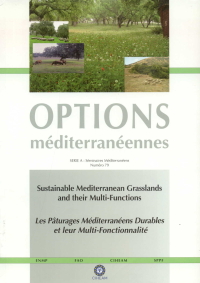| Article précédent | p. 443-447 | Article suivant |
Bioactivators and nitrogen fertilization applied to durum wheat: effects on the chemical composition and in vitro digestibility of straw
The objective of this research was to study the effects of three nitrogen fertilisation levels and bio-activators on the chemical composition and dry and organic matter digestibilities of durum wheat straw. The following applications of bio-activators were compared; mycorrhizal, Azospirillum and mycorrhizal plus Azospirillum inoculation and in addition a control with no application. These treatments were in factorial combination with three levels of N fertilization (0, 50, 100 kg/ha of N). The following parameters were determined: dry matter, crude protein, ether extract, ash, neutral detergent fibre, acid detergent fibre and acid detergent lignin. Hemicellulose and cellulose were estimated. The highest dose of nitrogen fertilizer increased neutral and acid detergent fibre and cellulose straw percentages. The two bio-activators had different effects on the quality of the straw: the mycorrhizal bio-activator increased neutral and acid detergent fibre and the cellulose contents of the straw, the Azospirillum also showed an increase in the same parameters. Neither treatment affected dry and organic matter digestibilities. The results of this research show that high levels of nitrogen can have a negative effect on the quality of straw and it is therefore recommended that a quantity of 50 kg/ha of N be used. Mycorrhizal, even in small doses, reduced fibre and increased cellulose content.
L'objectif de cette recherche était d'étudier les effets de trois niveaux de fertilisation azotée et de bioactivateurs sur la composition chimique et sur la digestibilité de la matière organique de la paille de blé dur. Les applications suivantes des bioactivateurs ont été comparées : inoculation de mycorhize, d'Azospirillum, de combinaison de mycorhize avec Azospirillum et un témoin sans application. Ces traitements sont mis en combinaison factorielle avec trois niveaux de fertilisation azotée (0, 50, 100 kg ha-1 de N). Les paramètres suivants ont été déterminés : matière sèche, protéine brute, extrait d'éther, cendre, fibre au détergent neutre, fibre au détergent acide et lignine au détergent acide. Par contre l'hémicellulose et la cellulose ont été estimées. La dose la plus élevée d'azote a augmenté les pourcentages de fibre au détergent neutre, de fibre au détergent acide et de cellulose de la paille. Les deux bioactivateurs ont influencé de manière diverse la qualité de la paille, la mycorhize a diminué la teneur en fibre au détergent neutre, de fibre au détergent acide et de cellulose de la paille, par contre l'Azospirillum a déterminé un accroissement de ces mêmes paramètres. Ces traitements n'ont pas affecté la digestibilité de la matière sèche et organique. Les résultats de cette recherche ont montré que de hauts apports azotés influencent d'une manière négative la qualité de la paille, par conséquent il est conseillé l'utilisation de 50 kg ha-1 de N. La mycorhize, même à faible dose, a réduit la teneur en fibre et a augmenté celle de la cellulose.
- [ Afficher ]
- [ Télécharger ]
- [ Exporter la citation ]
Vous pouvez télécharger la citation au format :
- [ Imprimer ]
-
Mots-clés
BLE DUR, COMPOSITION CHIMIQUE, DIGESTIBILITE, ENGRAIS AZOTE, FIBRE ALIMENTAIRE, PAILLE DE BLE, PROTEINE BRUTE, QUALITECiter cet article
De Giorgio D., Lestingi A., Bovera F., Convertini G. Bioactivators and nitrogen fertilization applied to durum wheat: effects on the chemical composition and in vitro digestibility of straw. In : Porqueddu C. (ed.), Tavares de Sousa M.M. (ed.). Sustainable Mediterranean grasslands and their multi-functions . Zaragoza : CIHEAM / FAO / ENMP / SPPF, 2008. p. 443-447. (Options Méditerranéennes : Série A. Séminaires Méditerranéens; n. 79). 12. Meeting of the Sub-Network on Mediterranean Forage Resources of the FAO-CIHEAM Inter-regional Cooperative Research and Development Network on Pastures and Fodder Crop, 2008/04/09-12, Elvas (Portugal). http://om.ciheam.org/om/pdf/a79/00800694.pdf



